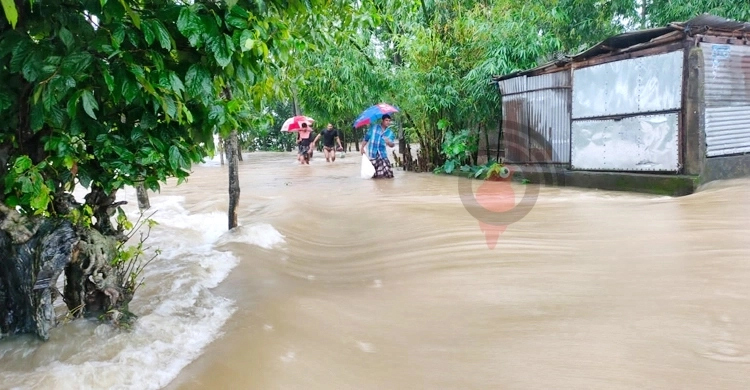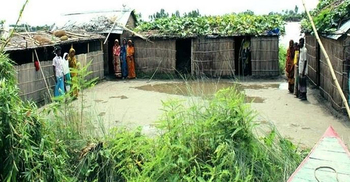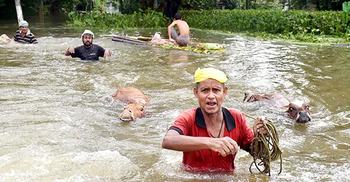Diseases spread as floodwater starts receding

Waterborne diseases are spreading in the flood-hit regions of Bangladesh as floodwater started receding.
“Many people are suffering from diarrhoea, skin diseases, dysentery, cholera and other waterborne diseases,” Directorate General of Health Services (DGHS) sources said.
In the past 24 hours, a total of 452 people have been affected by diarrhoea in four flood-hit divisions -- Sylhet, Rangpur, Chattagram and Mymensingh -- while 53 people have also suffered from skin diseases, a press release issued by the DGHS said.
To provide healthcare support to the flood-affected regions of the country, as many as 2,050 medical teams have been working since the beginning of the flood, it added.
Officials said people of the flood-affected areas in Bangladesh are returning back home as the flood situation is improving continuously.
"Flood in the northeastern and northern region is improving gradually as both Bangladesh and upstream regions of India witnessed less rainfall in the past three days," Flood Forecasting and Warning Centre (FFWC) spokesman Md Arifuzzaman Bhuyan told BSS.
"Country's major rivers are flowing below danger levels at their most monitoring stations....meaning flood situation is an improving trend," he added. The situation is the worst since the 2004 flooding, Bhuiyan, an FFWC executive engineer, said heavy downpours inside Bangladesh and the upstream region of India triggered devastating floods in Brahmaputra and Meghna basins.
Monsoon rains and gushing waters from upstream India worsened Bangladesh's flood situation with experts calling it the worst since 2004 while millions of people have been affected by the deluge, the FFWC official said.
Northeastern and northern parts of Bangladesh may witness prolonged floods as record-breaking rainfalls were recorded inside Bangladesh and upstream states of India during the ongoing flood.
"We have seen that both Bangladesh and upstream states of Meghalaya and Assam and western Himalayan regions of India recorded heavy rainfall, the highest over 100 years," Professor Md Mansur Rahman of the Institute of Water and Flood Management of BUET said.
Major rivers and their tributaries of Bangladesh have no capacity to contain such a huge volume of rains, which ultimately has caused massive flooding in northeastern and northern regions of the country, he added.
Mansur said there is a huge gap between Bangladesh and upstream regions of India in terms of elevation from sea level. "So, the onrush of water enters Bangladesh with a faster pace, which inundated vast areas of the country in a shorter time," he added.
The hydrologist said a large number of embankments have been built in both Bangladesh and Indian regions to control the flow of water of major rivers, which are the main reasons for the increasing frequency of flooding.
The ongoing flood in the Meghna basin may prolong as "the only exit point of flood water is Bhairab at the Megna river will take much time to pass such huge volume of flood water into the Bay of Bangal... meaning flood in the northeastern region is likely to be prolonged if the heavy downpour continues."
Water levels at 15 river stations monitored by Flood Forecasting and Warning Centre (FFWC) have marked a rise while 91 stations recorded a fall.
Among the 109 monitored stations, three river stations have been registered steady while water levels at seven stations are flowing above the danger level, a bulletin issued by the FFWC said here today.
The Surma at Kanaighat, the Kushiyara at Amalshid and Sheola, the Old Surma at Derai, the Baulai at Khaliajuri, the Someswari at Kalmakanda and the Titas at Brahmanbaria are flowing above danger level by 75cm, 169cm, 60cm, 30cm, 17cm, 39cm and 25cm respectively.
All the major rivers in the country are on a falling trend, the FFWC bulletin added.
The Brahmaputa-Jamuna, Ganges-Padma and all the major rivers of the north-eastern region of the country may continue falling in the next 48 hours, while the Dharala and Dudhkumar rivers of northern Bangladesh may continue falling in the next 24 hours, it added.
In the next 48-72 hours, there is a chance of heavy rainfall at places of the Sub-Himalayan West-Bengal (Jalpaiguri, Sikkim). As a result, the water level of the Teesta river may rise and close to the danger level at Dalia Point.
Flood situation in the Sylhet, Sunamganj, Netrokona, Kishoreganj and Brahmanbaria districts may continue improving in the next 24 hours, the FFWC bulletin said, adding, that there is a chance of short-duration flood in the low-lying areas of Shariatpur and Madaripur districts in next 24 hours.
Source: BSS





